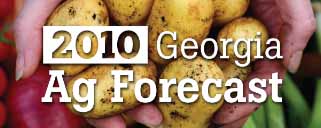Last year, most commodity prices dropped by 10 percent, leaving Georgia farmers facing their first significant decline in farm gate value in a decade. University of Georgia economists say 2010 should be a better year for them.
“The best thing we can say about 2009 is ‘it’s over,’” UGA economist Curt Lacy told a group gathered in Rome, Ga., Jan. 25 to hear the UGA College of Agricultural and Environmental Sciences’ 2010 Georgia Ag Forecast. “However, agriculture is still in pretty good shape, especially in Georgia.”
In 2009, commodity and livestock prices were lower than they were in 2008. Net farm income dropped by 38 percent compared to 2008, according the U.S. Department of Agriculture.
However, Georgia’s net farm income should improve in 2010.
Farm land values also took a tumble. Decreases in commercial and residential development, demand for recreational land and farm commodity prices discouraged aggressive farm real estate investments, causing Georgia’s farm real estate values to fall by 7 percent over 2008 levels.
Consumer food prices will increase by 3 percent to 4 percent in 2010, due largely to the strengthening U.S. economy and likely cuts in some farm products in response to the poor returns in 2009. Food prices in 2009 were up only 2 percent, the lowest food-price increase in decades.
“It is important to recognize that 2009 was an unusual year in the past decade,” said economist John McKissick, director of the UGA Center for Agribusiness and Economic Development. “Georgia agriculture and agribusiness have continued to grow and prosper through most of the last 10 years despite droughts and volatile prices. And 2010, while presenting some new challenges, is at least likely to return the industry to a growth path.”
But, McKissick said “a recovery to 2008 levels is doubtful within the next year or two.”
Unemployment is key recovery factor
Unemployment is the largest factor affecting the agricultural industry. “Demand hinges on improving unemployment numbers,” Lacy said. “How much money people spend on food, especially meat, depends on the disposable income they have available.”
Another key factor for Georgia agriculture is the strength of the U.S. dollar on the world market. “A weak U.S. dollar makes our products more affordable to customers,” Lacy said. “That’s good in terms of exports.”
For imports, it’s a different story.
“We import about 50 percent of the fertilizer we use,” he said. “It hurts profits because a weak dollar means we have to pay more for vital inputs.”
Meat, milk and crops
Georgia’s animal agriculture industry suffered last year from weak consumer demand which brought down meat and milk product prices. Producers also faced high feed prices and increased transportation costs to get the meat to market, further cutting profits. Two major dairy buyouts and restructuring of the nation’s largest broiler producer caused further declines in industry production.
Crops faired much better than livestock in 2009 and should see continued improvement in 2010. “Barring any major weather problems, most crops should rebound in 2010,” Lacy said.
A record peanut harvest in 2008 created a large surplus and marketing challenges for producers in 2009, McKissick said. “In addition, uncertainty over peanut product demand was heightened by the food quality and safety issues brought about by a single Georgia peanut butter processor. The resulting uncertainties lead to significant production and processing adjustments, but should help the industry rebound in 2010.”
Other row crops prices were fair in 2009 with record yields. Major input costs for Georgia crops should moderate in 2010, helping producers’ economic bottom lines.
“The large ‘green,’ or ornamental horticulture, industry and related landscape services sector continued to feel lingering impacts of the 2007 to 2009 drought restrictions,” McKissick said. “While many drought restrictions have been reduced, the industries’ rebound in 2010 will depend on recovery in consumer spending for green industry products and services and a rebound in the housing industry.”
“Agriculture is growing in Georgia,” said Scott Angle, CAES dean and director. “As California faces growing water problems and Florida has increasing land use issues, many are looking to Georgia to be the breadbasket of the nation. So, we fully expect the agriculture industry here to continue to grow.”
The annual economic forecast is presented regionally across the state. Along with the 2010 outlook this year, scientists with the UGA Center for Food Safety gave updates on national and state food safety policy.






.jpg)

